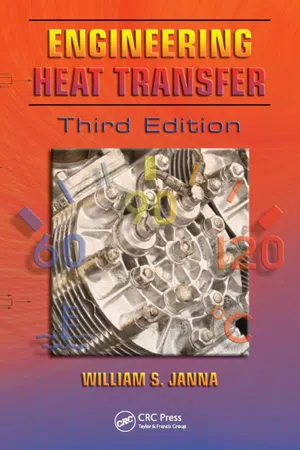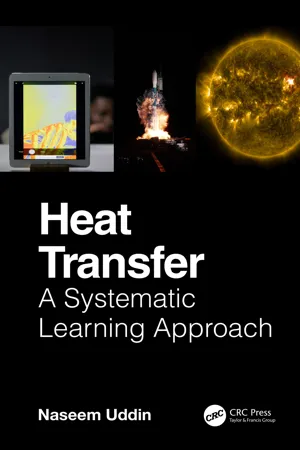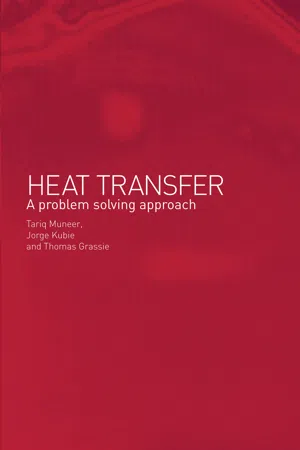Technology & Engineering
Natural Convection
Natural convection is a heat transfer process driven by density differences in a fluid due to temperature variations. As a fluid is heated, it becomes less dense and rises, while cooler, denser fluid descends. This movement creates a natural circulation pattern, transferring heat without the need for external mechanical devices. Natural convection is commonly observed in various engineering and environmental systems.
Written by Perlego with AI-assistance
Related key terms
Related key terms
1 of 4
Related key terms
1 of 3
7 Key excerpts on "Natural Convection"
- eBook - ePub
- William S. Janna(Author)
- 2018(Publication Date)
- CRC Press(Publisher)
8 Natural-Convection Systems 8.1 IntroductionThe subject of natural or free convection was discussed in Chapter 5 . Exact solutions for several natural-convection problems were derived. In this chapter, we continue the discussion and examine many natural-convection problems in detail.Forced-convection problems involve the use of an external motive device that moves fluid past an object that has a temperature different from that of the fluid. Natural-convection problems contain no such external fluid-moving device. Instead, the fluid in a natural-convection system moves due to a density gradient that is acted upon by a body force. Density gradients are due to a temperature gradient, and the body force has been attributed to gravity.It is important to note that body forces other than gravity can act to move the fluid in a natural-convection problem. For example, centripetal acceleration is a body force that exists in rotating machinery. The Coriolis force is a body force that is significant in oceanic and atmospheric motions. Although a number of variations can exist, in this chapter we work primarily with natural-convection problems where the body force is gravitational and the density gradient is due to a temperature gradient.Compared to forced-convection problems, natural-convection systems are characterized by smaller velocities, small convection coefficients, and correspondingly smaller heat-transfer rates. They are no less significant, however, because of the numerous applications that exist. For instance, a covered pot containing coffee at 150°F loses heat primarily by Natural Convection. Based on the natural-convection heat loss, a suitable heater must be selected that will maintain the coffee at the proper temperature. A steam pipe suspended from a ceiling loses heat by radiation and by Natural Convection. The magnitude of the convection heat loss must be calculated to determine insulation requirements. Foods placed in a conventional oven are heated by a natural-convection process. It is therefore important to be able to properly model natural-convection systems.* - eBook - ePub
- Da-Wen Sun, Da-Wen Sun, Da-Wen Sun(Authors)
- 2018(Publication Date)
- CRC Press(Publisher)
Temperature distribution inside a cooling or freezing room, for example, will be significant to properly design the whole process where the temperature change inside the product will be an additional concern. Heat transfer by Natural Convection in domestic refrigerators is a typical example of this case [ 1 ]. In the cold storage or freezing rooms, however, effects of Natural Convection in addition to the forced convection (where the fluid movement is forced using a fan, for example) will need to be quantified and considered for design purposes. 15.2 Natural Convection Heat Transfer 15.2.1 Fundamentals Convection heat transfer can be considered in two cases: forced and Natural Convection. In the first case, fluid motion is obtained by an external force like a pump or fan; in the second, it is triggered naturally due to evolution of buoyancy forces occurring with density changes with temperature. Because of the fluid motion, convection heat transfer is expected to take place much faster than conduction heat transfer with respect to the temperature increase. Erdogdu et al. [ 2 ] was one of the first to demonstrate the comparison of Natural Convection and conduction in a cylindrical cavity where the experimental studies were carried out in pasteurization conditions and used to validate the developed CFD models. In a fluid medium, when there is a change in the density of a fluid, there will be an upward (with a decrease in the density of the fluid due to increase in its temperature—heating process) or downward forces (with an increase in the density due to the decrease in its temperature—cooling process) created. All these changes are based on the gravitational forces, and quantifying the gravitational force over the viscous forces and/or inertial forces is required to understand the dominating force mechanism on the change of temperature and flow field evolution - eBook - ePub
Heat Transfer
A Systematic Learning Approach
- Naseem Uddin(Author)
- 2024(Publication Date)
- CRC Press(Publisher)
11 Natural and Mixed ConvectionDOI: 10.1201/9781003428404-11In this chapter, we will discuss the heat transfer caused by the buoyancy driven flow, which is classified as natural or free convection. In engineering applications, we sometimes design equipment which have no fans and thus the flow is generated due to density changes. In some cases, both forced and free convection are present. We will develop an analytical solution for the laminar free convection boundary layer along a vertical flat plate, and we will also explore correlations to be used for variety of situations. After finishing this chapter, one will be able to:- ■ Calculate the Natural Convection related heat transfer from vertical flat surface.
- ■ Calculate the Natural Convection related heat transfer in enclosures.
- ■ Decide about the type of convective heat transfer involved using the criterion given in this chapter.
- ■ Compute heat transfer in case of mixed convection scenarios.
Natural Convection is important not only for the design of devices which involves no fans but also for the buoyancy-induced motions in the atmosphere, and in bodies of water. Natural Convection has gained more importance since the use of nano-scale devices has been started at the turn of the century. The phenomenon of natural or free convection is different from forced convection. The fluid close to the heated wall becomes lighter and rises. This fluid is shed at the top of the object as a wake, which may arise as a plume. Hence, fluid from the extensive medium continually flows into the convection region near the surface to replace the rising material.11.1 OBERBECK-BOUSSINESQ-APPROXIMATION
In case of free or Natural Convection, the movement of the fluid occurs exclusively due to density change as a result of temperature differences. We know that density is a function of temperature and because of its change the Buoyancy force will be the main driving force for the fluid. The Navier-Stokes equation is - eBook - ePub
- Anthony Mills(Author)
- 2018(Publication Date)
- CRC Press(Publisher)
β of liquids are given in Table A. 10.Natural Convection flows can be either external or internal. External flows include flow up a heated wall and the plume rising above a power plant stack. Internal flows are found between the cover plate and absorbing surface of a solar collector and inside hollow insulating walls. Velocities associated with Natural Convection are relatively small, not much more than 2 m/s. Thus, natural-convection heat transfer coefficients tend to be much smaller than those for forced convection. For gases, these coefficients are of the order of only 5 W/m2 K, and the engineer must be careful to always check if simultaneous radiation heat transfer is significant to the thermal design. Since there is no obvious characteristic velocity of a Natural Convection flow, the Reynolds number of forced convection does not play a role. It is replaced by the Grashof or Rayleigh number.4.4.1 External Natural FlowsIn this section, various external Natural Convection flows are considered, and correlations are given for heat transfer from isothermal surfaces. Other wall boundary conditions are discussed at the end of the section.Flow on a Vertical WallFigure 4.30 shows a natural-convection boundary layer on a vertical plate. A laminar boundary layer forms at the lower end, and transition to a turbulent boundary layer occurs at a critical value of the Rayleigh number Rax = ßΔTgx3 /vα − 109 . Since Rax = Grx Pr, where the Grashof number Grx = ßΔTgx3 /v2 , for gases with Pr ≃ 1, transition can be said to occur at Grx ≃ 109 (see Section 1.3.3 ). Following Churchill and Usagi [21] , we define a Prandtl number function Ψ asFigure 4.30 - eBook - ePub
Practical Guide to the Packaging of Electronics
Thermal and Mechanical Design and Analysis, Third Edition
- Ali Jamnia(Author)
- 2016(Publication Date)
- CRC Press(Publisher)
One potential pitfall that the design engineer must be aware of is the impact of geographic altitude on the convection and its ability to remove heat. Commonly, equipment temperatures for many electronics packages are calculated for sea level conditions. An appreciable change in altitude will create a significant variation in both pressure and density. These two variables will impact temperature levels. Consequently, temperature values need to be recalculated when the same equipment is used in higher altitudes—either on airborne systems or in high-altitude places. We will discuss this later.Free (or Natural) Convection
One technique used in cooling electronics is to take advantage of free (natural) convection. By taking advantage of heat rising, it is possible to design a system whereby cool air enters the enclosure from the bottom and warm air exits from the top. Note that the words “cool” and “warm” as opposed to “cold” and “hot” are used. When free convection is used to cool a system, temperature rises must be moderate.In free convection, fluid flow is developed under the influence of buoyancy forces. Depending on the orientation of the heat source with respect to gravity, the flow field may be nonexistent, simple, or very complicated. It should also be noted that flow might start as laminar but develop into turbulent.To study the relationship between the buoyancy and the ability of the fluid to remove heat, we need to reexamine the following nondimensional relationships:N u =h LKN u =L 3ρ 2g β Δ Tμ 2P r =KC pμwhere L is a characteristic length, ρ is the density of the fluid, g is gravity, β is the coefficient of fluid expansion, ΔT is the change in temperature, μ is fluid viscosity,Cpis fluid specific heat, h his the coefficient of heat transfer, and k - eBook - ePub
Heat Transfer
A Problem Solving Approach
- Kubie Jorge, Tariq Muneer, Grassie Thomas(Authors)
- 2012(Publication Date)
- Routledge(Publisher)
Table 6.1.1 show that, while there is a degree of overlap between the values associated with forced and Natural Convection, forced convection effects are generally dominant. In considering the combined effects of forced and Natural Convection Burmeister (1983) suggests that one rationale for the design procedure is to calculate the respective forced and Natural Convection coefficients separately, and to then adopt the larger value.This simple method however can obviously produce a large error in the estimated heat transfer for the given situation. An alternative method is to use the dimensionless group , being a measure of the ratio of buoyancy to inertial forces, to provide an indication of the relative effects of the two convection heat transfer mechanisms considered. Where is large (i.e. 1), the effects of Natural Convection will be dominant, whereas, if the above ratio is small ( 1), then forced convection will prevail. Holman (1990) states that when > 10, Natural Convection will be of primary importance.In presenting the relevant relations, it is necessary to consider the direction of the forced flow in relation to that established through buoyancy effects. We shall therefore first consider the case of aiding flow.8.4.1 Aiding flow
Where the direction of forced flow aids that established through buoyancy effects, Churchill (1977) suggests that the relationship defined in Eq. (8.4.1) is applied:where the forced and free regressions applicable for the specific geometry are used to determine the respective Nusselt numbers.For < 0.1, for the present case of aiding flow, Lloyd and Sparrow (1970) found that, for Pr ≈ 1, the influence of Natural Convection was less than 5%. Conversely, Acrivos (1958) had earlier shown that, for laminar flow over a vertical plate, the effect of forced convection was less than 10% for both > 4 and 0.73 < Pr < 10 and also for - Pallippattu Krishnan Vijayan, Arun K. Nayak, Naveen Kumar(Authors)
- 2019(Publication Date)
- Woodhead Publishing(Publisher)
The heat transport capability of NCSs depends on the flow generated. We have seen earlier that an NCL can be designed to generate any desired flow rate. Therefore an NCL can also be designed for any desired heat transport capability. For example, mini NCLs with heat transport capability of a few tens of W have been designed for computer cooling, whereas the heat transport capability of a NC-based ESBWR is 4500 MW. Ironically, 3926 MW is transported in ABWR with a pumping power of 12.7 MW, whereas ESBWR transports 4500 MW without any external pumping power!1.3.2 Natural Convection and natural circulation are synonymous
Several researchers do not differentiate between Natural Convection and NC. Both Natural Convection and NC flows are driven by buoyancy force and the similarity ends there. Just as Natural Convection and forced convection are different, Natural Convection and NC are also different. This would be clear from the following examples: (1) Natural Convection in an enclosed space (see Fig. 1.2A ) and (2) external Natural Convection (see Fig. 1.2B ). In the case of Natural Convection in enclosed space, there is no net flow across the cross-section (say X–X), whereas there is always a unidirectional flow in the case of NC. In the case of external Natural Convection, one is only interested in the heat transfer from the surface and does not worry about what happens to the flow, whereas in NC one is interested in the full circulation path and what happens to the fluid over the entire flow path.Figure 1.2 Internal and external Natural Convection. (A) Natural Convection in enclosed space. (B) External Natural Convection.1.3.3 Natural circulation is not forced
Often researchers compare NC with forced circulation. This gives the reader the impression that NC is not forced. This is not true as NC is driven by the buoyancy force generated by the density gradient resulting from the process of heat transport from the source to the sink.
Index pages curate the most relevant extracts from our library of academic textbooks. They’ve been created using an in-house natural language model (NLM), each adding context and meaning to key research topics.
Explore more topic indexes
Explore more topic indexes
1 of 6
Explore more topic indexes
1 of 4






